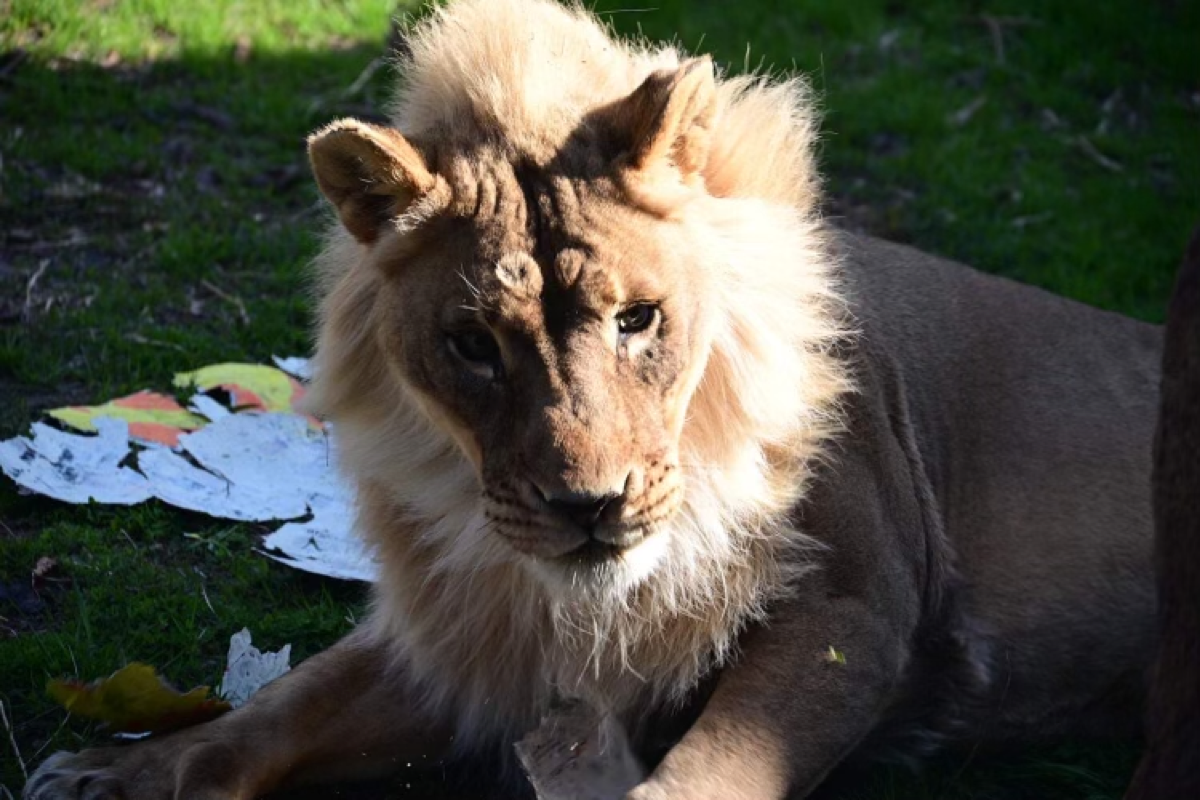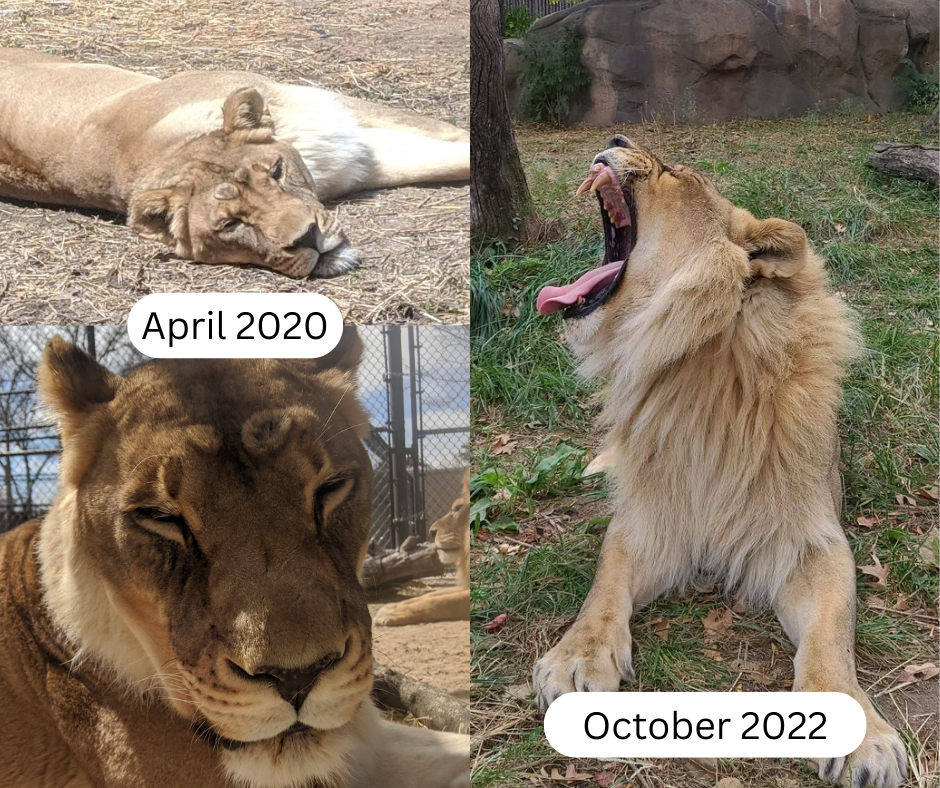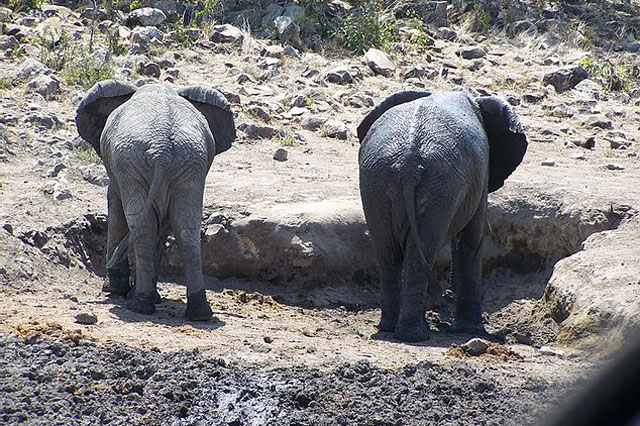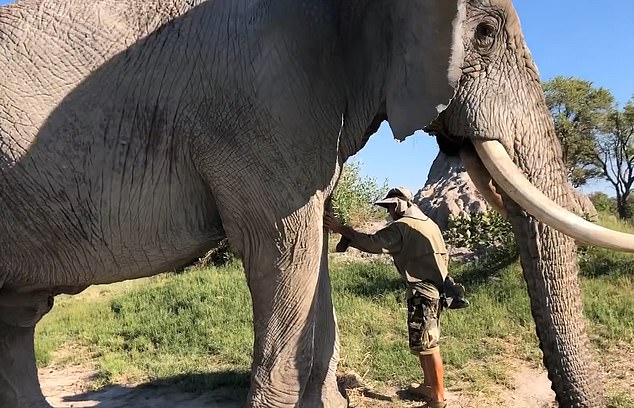Caretakers at Topeka Zoo in Kansas are trying to piece together why one of their lionesses is suddenly sporting the extra fur.
A lion’s mane is a striking feature—the bigger and darker those luscious locks, the more appealing to lionesses. This classic example of sexual dimophism is primarily flaunted by the males of the species. But caretakers at Topeka Zoo and Conservation Center in Kansas have reported that in late fall 2020, one of their lionesses, Zuri, has grown a mini-mane of her own.

“It’s extremely rare,” says Shanna Simpson, animal curator at the Topeka Zoo. “We never even heard about this happening until we saw Zuri.”
Zuri currently looks a bit like a teenage male lion just beginning to grow out a mane despite being an 18-year-old female. The caretakers began to notice the tresses after Avus, the only male of the zoo’s three lions, died in October 2020, Simpson suggesting that the new do may be linked to a change in hormones and that she may be taking on more of a protector role of the pride. Zuri and her same-aged sister Asante arrived at Topeka Zoo in 2006 and are currently the only members of their species there.
Lions are the only known big cats to form unique social structures. The females do most of the hunting and care for the cubs, while the males’ primary job is to keep rivals away and protect the pride, says Simpson. The days after Avus passed away, zoo caretakers were surprised to observe unusual behavior in Asante and Zuri. They were more skittish, jumpy, and were not eating as much, Simpson recalls.
“Usually, lions are very confident animals. They don’t care who or what’s around them because very few things threaten them,” she says.
Around one to two months later, Zuri also started to grow longer patches of fur around her nape. Simpson had asked her colleagues at other zoos about the odd new mane, and found that—while very rare—other lionesses have been spotted with them, both in captivity and in the wild.
In 2011, the National Zoological Gardens of South Africa’s lioness had a mane; and in 2018, the Oklahoma City Zoo’s 18-year-old lioness sported a shaggy beard. Tests on the lioness at the National Zoological Gardens detected high levels of testosterone, which researchers associated with a problem in the ovaries. After her death, the Oklahoma City Zoo found that their lioness had a benign tumor that likely caused elevated hormone levels.
Meanwhile, a 2016 study in the African Journal of Ecology reported five wild lionesses with manes in the Moremi Game Reserve in Botswana. While blood samples and health exams could not be conducted, the team studying the wild lionesses in Botswana observed that the maned lionesses were seen mating but none of them became pregnant, leading them to surmise that the females could be infertile possibly due to high levels of testosterone. (While exact ages couldn’t be determined, the researchers estimated maned lionesses aged three to 11 years old.)
“We know that manes are testosterone-dependent,” Bruce Patterson, curator emeritus of mammals at the Field Museum of Natural History in Chicago, wrote to PopSci in an email. “Males only grow their manes with the onset of sexual maturity, and this continues into adulthood.”
 Zuri’s mini-mane progress from 2020 to 2022. Topeka Zoo & Conservation Center
Zuri’s mini-mane progress from 2020 to 2022. Topeka Zoo & Conservation Center
In African lions, male cubs typically begin to develop manes around 18 months when they become sexually mature. Researchers have documented malnourished and sick male lions with unhealthy hair and sparser manes. “The better the mane on a male lion, the more testosterone they have, which just makes sense,” Simpson says. “You have to be able to breed. You have to be able to protect your pride. So you have to have that level of aggression that often comes with more testosterone. The wild’s no joke. It’s brutal out there.”
While Topeka Zoo does conduct full health checkups and safely takes blood samples from their lions, testosterone levels haven’t been included in regular tests. “That is something that I would love to look into,” says Simpson. Patterson, who has worked with Topeka Zoo’s lions to study manes in the past, believes it’s possible that Zuri is experiencing hormone shifts like other maned lionesses. “I’m guessing that either [Zuri’s] social position among the remaining lions has elicited heightened androgen production, or perhaps her ovarian production of female hormones is impaired,” he explains.
Zuri had always been a lioness in charge, says Simpson. Avus maintained the dominant male leader position, however “Zuri kind of ruled the day-to-day stuff,” says Simpson. While Avus did bear a cub with Asante, he never attempted to mate with Zuri, Simpson says. In his absence, Simpson suggests that Zuri might be taking on a “protector role” for her and her sister.
However, Kris Everatt, conservation scientist for Panthera, a global wild cat conservation organization, isn’t quite convinced that Avus’ death triggered the role change or Zuri’s mane. “I don’t think that the loss of a male would bring that result at all,” says Everatt, who has studied poaching and stewardship of wild African lions. “Maybe this lioness is more dominant than the others, and maybe that’s related to her hormones, but there isn’t a hierarchy [or competition] among lionesses within a pride in the wild.”
The exact cause for the mane—and change in hormones—is unclear, especially seeing that the feature wouldn’t benefit a lioness in the same way as a lion. Physically, a big fluffy mane can be a disadvantage in the wild, Everatt explains—it isn’t ideal in hot habitats and makes it harder for lions to hide when they hunt. It’s why males in certain populations, like Kenya’s Tsavo lions, skip the flourish entirely, he says. “There isn’t any advantage other than the fact that it’s selected for sexually by females.” So, in the case of lionesses with manes, he adds, it’s most likely “just a fluke.”
Another possible explanation is that maned lionesses might have a slight difference in their genes, where the one for male sex hormones are expressed more than in other females. These differences in sex hormone levels might also happen in females of other animals, but the sexual dimorphism in lions makes it more noticable, Everatt says. “If the same thing happened, for instance, in a cheetah, or a leopard, or a wolf, we probably wouldn’t even notice,” he says. “When that happens with lions, it’s easy to notice [the mane], and so it grabs our attention like this. But it’s nothing special to lions.”

Everatt does note the significance of Zuri’s age—lions in the wild typically only live around 10 to 11 years old, while the median age for captive ones is about 14.5. The Topeka Zoo staff found it surprising to see a shift in hormones so late in age. “That’s interesting too that as late in life as she is, she has a hormonal change,” says Brendan Wiley, director of Topeka Zoo. “I think that is the thing that’s the most shocking.”
Zuri and Asante have since returned to their normal diets and habits, and have been “thriving” for their ripe ages, says Simpson. Aside from “being good-looking,” she adds, Zuri’s new mane doesn’t seem to be a sign of any health issues. In fact, many of the visitors at Topeka Zoo have mistaken the lioness for a new well-groomed lion, Simpson notes. “It’s really fun to engage with our guests and say, ‘That’s Zuri, the same lioness that’s been here your whole life.’”








